The first thing you probably think when you hear the term: fungal taxonomy is BORING!!! Well, to be honest, the nitty gritty "pull up your sleeves" species and subspecies taxonomy can get pretty arduous. But knowing the family and genus of the wild mushrooms you find, and / or are specifically looking for is very important. Taxonomy is all about classifying organisms based on their shared characteristics. So, obviously, taxonomic knowledge of mushrooms is essential if you expect to identify them! For example, all mushrooms in the family Tricholomaceae have white spores. All mushrooms in the family Tricholomaceae, genus Pleurotis (Oyster mushrooms) are wood rotters with white spores. If you come across a certain mushroom and examine its characteristics, habitat, etc. and know a bit of your taxonomy, you have a good chance at figuring out what it is you're looking at. As you will discover over time as a fungal forager, knowing a bit of fungal taxonomy will help you immensely in recognizing and remembering the beautiful and tasty 'fruits of the forest'.
Here are a few example 'inner dialogues' that I may run through when I am out in the field seeking out or trying to identify any particular species:
There seems to be alot of treefall here. I should be on the lookout for the wood saprophytes. I expect to find wood decay fungi such as the polypores, Pleurotis, Pholiota, perhaps even Armillaria and Flammulina.
I'm certain that this mushroom is from the genus Russula. I know the edibility test for Russulas, so it's just a matter of performing the test to decide wether I put it in my basket or not.
Hmm, this mushroom has a ring on its stem and warts on its cap. It is mature, and the gills are white. I know that Agaricus species have a ring, but don't have warts and have chocolate brown spore-laden gills when mature. Amanitas have a ring, some have warts on the cap, and all are white-spored. Let's look up Amanitas in my field guide...
Fungal taxonomy handles scientifically what you as a forager would probably do in your head: group fungi with similar qualities together. Of course, being scientific, fungal taxonomy is more about deeply rooted similarities that involve common ancestry amongst different organisms. Take for instance the genus Russula, which contains over 700 species. They vary greatly in color and size, but all are micorrhizal, all have pale colored spores (or white) and all have unique, brittle tissues. Molecular and genetic studies have found that Russula species evolved a long time ago and are strongly separate from most other mushrooms. For this reason, it has been proposed that a new order, the Russulales, be introduced to the fungal taxonomic tree. Fungal taxonomy is in the process of change as these molecular and genetic studies continue.
Most fungal taxonomy that you find in field identification guides is probably 'old school', and based on classical taxonomic divisions which were based primarily on field observations and microscopy. If you own more than one field guide, and the publication dates are significantly different, you may notice that some mushrooms' taxonomic names have changed in recent publications. In my opinion, the 'old school' classification scheme is actually more useful and easier for most wild mushroom enthusiasts, and I encourage you to trust your field guides and not worry about all this 'new fangled' mycological 'high society' stuff.
Allright, with all that behind us, let me show you the primary divisions among the macrofungi. I am leaving out groups that are not of any interest to the average forager. Also, this chart is not tecnically correct, as there are subdivisions, series, etc. within that would just make it more confusing for the layman. Additionally, some groups like the gasteromycetes have been severely adjusted into other groups recently. I have chosen a classical scheme that is most useful for the forager. Just roll with it, and you will find the layout useful and possibly enlightening.
|
| Phylum |
Class |
Order |
Families or Genera of note |
Example |
| |
|
|
(Families end with -ceae) |
|
Basidiomycota

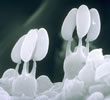
Spores produced on microscopic structures called basidia. In mushrooms, the gills are lined with millions of basidia.
|
Hymenomycetes.
Basidia occur on a fertile surface and are undivided. |
Agaricales. Classical mushrooms with gills or pores. |
Boletaceae. Classic mushroom shape with pores instead of gills. The porchini / Cepe is in this group. Mycorrhizal. |
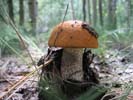 |
| Tricholoma. Very large genus, widespread. Pale spored mycorrhizal fungi, typically medium to large fruiting body. |
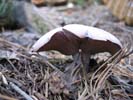 |
| Pleurotus. Oyster mushrooms. White spored, wood decaying. |
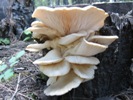 |
| Agaricus. Chocolate brown spored saprophytes of enriched detrius. White button and portabello are in this family. |
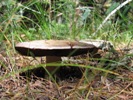 |
| Amanita. Common white spored mycorrhizal fungi of classical mushroom shape. |
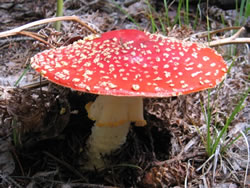 |
| Cortinariaceae. Giant group of brown spored gilled mushrooms. Most are inedible or poisonous. Many are mycorrhizal. |
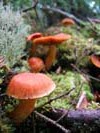 |
| Russulaceae. Only two genera but many species. Uniquely brittle flesh, pale spores, mycorrhizal. Common in woods. |
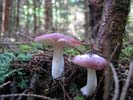 |
| Corprinaceae. Called "Inky Caps" because most members autodigest into spore-laden black ink at maturity. Typically decomposers of enriched detrius such as rotten wood or ruminant dung. |
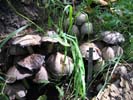 |
Aphyllophorales. Latin for "Don't have gills". A large 'cornucopia' group of several dissimilar families which don't fit into other orders. |
Polyporaceae. Large group of pored, usually shelf-shaped wood decay fungi. These are the primary wood-rotters in forests. |
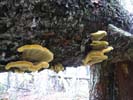 |
Cantherellaceae. Shallow, blunt 'gills' with pale spores, all mycorrhizal. Chantrelles and black trumpets are in this group. |
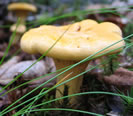 |
| Clavariaceae. Coral and club fungi. All are mycorrhizal with pale spores. |
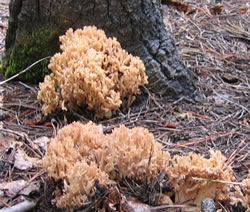 |
| Hydnaceae. Have "teeth" instead of gills. Some have a classical mushroom shape. The "Sweet Tooth" or hedgehog mushroom is in this group. |
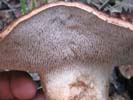 |
Dacrymycetales. Jelly fungi with unique fork-like basidia |
Dacrymyces (Witch's butter). Parasitizes wood rotting fungi. Often found on wet, rotted wood. |
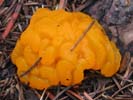 |
Phallales. Non-shooting basidia on gelatenous, smelly surfaces. |
Phallaceae. Classic stinkhorns, octopus stinkhorns, and others. |
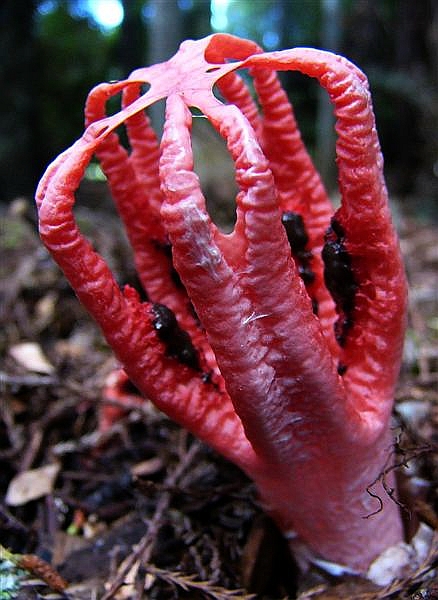
Photo:
Steve Reekie |
Phragobasidiomycetes. Basidia occur in gelatenous subdermal tissues and are split in half |
Tremellales and Auriculariales. Jelly like fungi that saprophytize wood. |
Tremella (genus) occurs as Witch's butter, also as Snow Fungus. Auricularua occurs as Cloud Ear / Black fungus and is popular in eastern dishes. |
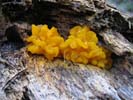 |
Gasteromycetes. Basidia develop in the interior of the fruiting body. Many are evolved from order Agaricales |
Nudulariales. Spores occur in packets which are nestled in tiny cups. |
Various genera but all quite similar. These are the "birds nest" fungi that use raindrops to propel their "eggs" away from the original colony. |
 |
| Lycoperdales. Single sac whose inner tissues develop into a dry mass of spores, then are released through disturbance. |
Lycoperdaceae. Classic puffballs. Ranges from small, acorn to quarter sized puffballs to soccer-ball sized giant puffballs. All are edible when immature. All are decomposers of rotten wood or soil detrius. |
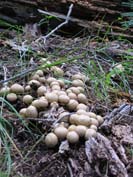 |
| Geastraceae. Earthstars. Very similar to the puffballs, but have a thick pre-segmented outer shell that opens and raises the inner puffball above the ground when wet. |
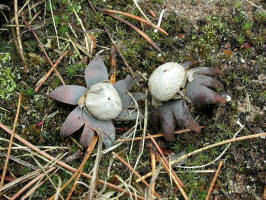
Photo: perverdonk.com |
Ascomycota.
Spores are produced in sacs called ascii that line a fertile layer on the mushroom.
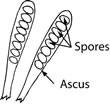
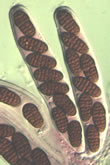 |
Pezizomycetes. The opening end of the ascus is a pivoting lid, rather than an open pore. |
Pezizales.
Ascii are on an open fertile surface called an apothecia.
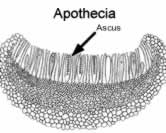
|
Morchellaceae. Fruiting body is a sponge-like compound apothecia. Morels are in this group. The poisonous false morel Gyromitra is not. |
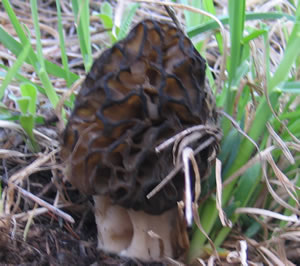 |
| Helvellaceae. Some are called "elfin saddles". Similar to morels, but with a single, often folded spore bearing surface. |
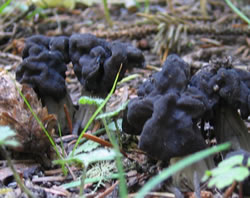 |
| Pezizaceae. Greatly ranging in size, these are the most obvious of the cup fungi. Saprophytic on decayed vegetation and other detrius. |
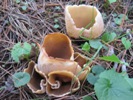 |
| Tuberaceae.
The famous truffle belongs to this group. The genus Tuber is a fully enclosed evolutionary end to other tightly folded members of Pezizales. Micorrhizal and found underground only. |
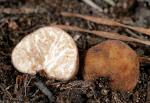
Photo: Fred Stevens |
| Sordariomycetes. The opening end of the Ascus is an open pore, rather than a pivoting lid. |
Hypocreales.
Ascii are in flasks under the surface, with a small opening exposed to the surface that ascospores are released from. A single flask is called a perithecia.
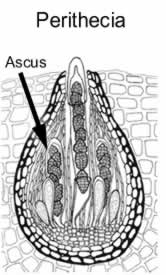 |
Hypomyces. A parasite of other mushrooms, the genus Hypomyces colonizes the entire fruiting body. Thousands of perithecial openings line the surface, and are often brightly colored. The lobster mushroom is is in this group and parasitizes the agaric family Russulaceae. |
 |




























